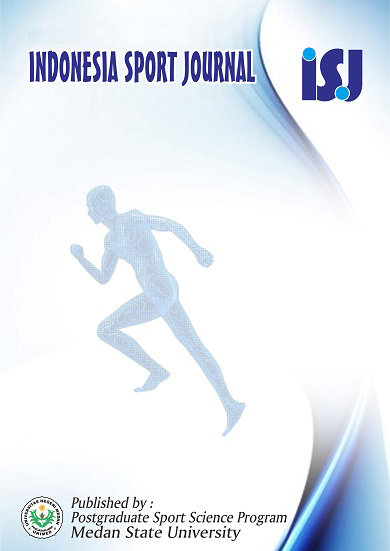CONTRIBUTION OF SPLIT SQUAD JUMP EXERCISES, MEDICINE BALL OVERHEAD THROW EXERCISES, AND DUMBBLE WRIST EXERCISES AGAINST SMASHES IN VOLLEYBALL WOMEN'S ATHLETES CLUB MULIA IN 2020
DOI:
https://doi.org/10.24114/isj.v5i2.37887Abstract
This study aims to determine the contribution of split squad jump exercises, medicine ball overhead throws, and dumbbell wirst exercises to smash in volleyball female athletes of the noble club in 2020. Statistical testing is assisted by the SPSS statistical program using descriptive tests, prerequisite tests for normality, linearity and tests. correlation and calculate the effective contribution and relative contribution of variables. The research sample was obtained by purposive sampling technique of 10 athletes. Before testing the hypothesis, they must pass the prerequisite test, namely, the normality test is the value > sig. 0.05 and the linearity test is greater than the 5% significance level, the regression correlation test shows that rcount > rtable. R table with the provisions of df = n-2 (10-2 = 8) in the two-way significance test of 0.05 is known to be 0.631. So that each independent variable with its dependent variable is significant. From the results of the prerequisite tests and statistical tests, the data obtained are SE 78.7% and SR 100%. This means that the contribution between the independent and dependent variables in this study is 78.7% while the remaining 21.3% is influenced by other variables outside the study. The results of this study indicate that (1) There is a Contribution of Split Squad Jump to Smash in Volleyball Putri Mulia Medan. (2) There is a Contribution of Medicine Ball Overhead Throw to the Smash in Putri Mulia Volleyball Ball in Medan. (3) There is a Dumbbell Wrist's Contribution to the Smash in the Putri Mulia Volleyball Ball in Medan. (4) There is a contribution of Split Squad Jump, Medicine Ball Overhead Throw and Dumbbell Wrist to Smash on Putri Mulia Volleyball Ball in Medan.Keywords : Split Squad Jump, Medicine Ball Overhead Throw, Dumbbell Wrist, Smash, VolleyballReferences
Adi Suriatno. (2018). œPengaruh Latihan Split Squad Jump Terhadap Peningkatan Power Otot Tungkai Dan Ketepatan Smash Dalam Permainan Bola Voly.
Ahmadi. (2007). œPanduan Olahraga Bola Voli. Surakarta: PNRI
Arikunto, S. (2006). œMetode Penelitian Kualitatif. Jakarta: BumiAksara
Bompa, T.O. &Harf, G.G. (2009).Periodization Training for Sports: Theory and Methodelogy of Training. Fifth Edition.United State of America: Human Kinetics.
Bafirman. (2009). œPembinaan Kondisi Fisik. Padang, Malang. Wineka Media
Cristivani Nasaru. (2014). œPengaruh Latihan Split Squat Jump Terhadap Peningkatan Power Tungkai dan Ketepatan Smash dalam Olahraga Bola Voli pada Siswa SMA Negeri 1 Tapa. Skripsi. Gorontalo: FIK UNG.
Dieter Beutelsthal. (2005). Belajar Bermain Bola Volley. Bandung : CV Pionir. Jaya.
Donald A Chu. (2000). œJumping into Plyometrics. Champaign, Illinois: Human Kinetics Publik.
Fitriyani, w. (2014). œDeskripsi Literasi Sains dalam Model Inquiri pada Materi Laju Reaksi di SMAN 9 Pontianak.(Skripsi). FKIP, Universitas Tanjungpura. Pontianak.
Gobel, Djubaera. (2004).œPengaruh Latihan Dumbell Terhadap Ketepatan Servis Bawah Pada Permainan Bola Voli. Skripsi. Jurusan Pendidikan Keolahragaan: IKIP Hadjarati, Hartono. 2010. Bahan Ajar Ilmu Kepelatihan Dasar. FIKK: UNG.
Haritsa, N.F. Trisnowiyanto. (2016). œPerbedaan Efek Latihan Medicine Ball Dan Clapping Push Up Terhadap Daya Ledak Otot Lengan Pemain Bulu tangkis RemajaUsia 13 “16 Tahun. Jurnal Kesehatan, ISSN 1979-7621, Vol. 1, No. 1, Juni 2016: 51-60.
Mahardika, I Wyn, Sudiana, I Kt., danSudarmada, I Nyn. (2014). œPengaruh pelatihan medicine ball scoop toss dan medicine ball throw terhadap peningkatan daya ledak otot lengan. Journal Ilmu Keolahragaan,vo 12. Singaraja: Universitas Pendidikan Ganesha.
Mahdi Juniarto.(Volume 5 Nomor 1, 2018).œPengaruhLatihan Dumbbell Curl Terhadap Kemampuan Hasil Smahs Pada Permainan Bola VoliSiswa Putra SMA N 1 Sambella Lombok Timur Tahun Pelajaaran 2016/2017.
Mylsidayu, A dan Kurniawan, F. (2015). œIlmu Kepelatihan Dasar. Ed. Bandung: Penerbit Alfabeta.
Nanang Martono. (2010).œMetode Penelitian Kuantitatif. Jakarta. Rajawali Pers
Nurhasan. (2001). œTes dan Pengukuran Dalam Pendidikan Jasmani. Jakarta: Direktorat Jendral Olahraga.
Pate. R.R,. McClenaghan, B. Rotella, R. (1993). œDasar-Dasar Ilmiah Kepelatihan. (terj. Kasiyo Dwijowinoto). Semarang: IKIP Semarang.
Rosmita. (2009). œManajemen Pendidikan Jasmanidan Olahraga. Bandung: FPOK-UPI
Sajoto. (2004). œPeningkatan dan Pembinaa Kekuatan Kondisi Fisik DalamOlah Raga. Semarang: Dahara prize.
Sukadiyanto. (2005).Pengantar Teori Dan Melatih Fisik. Yogyakarta: FIK Universitas Negeri Yogyakarta.
Sukadiyanto. 2010 œPengantar teori dan meto-dologi melatih fisik. Yogyakarta: Universitas Negeri Yogyakarta.
Sudjana. (2002). Statistika. Bandung: PT.Tarsito.
Sugiyono. (2010). œMetodePenelitianPendidikanPendekatanKuantitatif, kualitatif, dan R&D. Bandung: Alfabeta.
SuharsimiArikunto. (2002). InstrumenPenelitian. Jakarta: PT. RinekaCipta.
Surisman. (2010). StatistikaDasar. Bandar Lampung: Universitas Lampung





